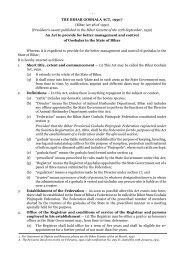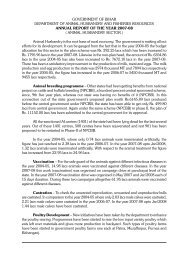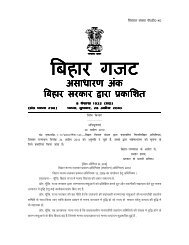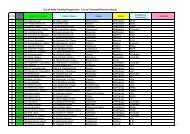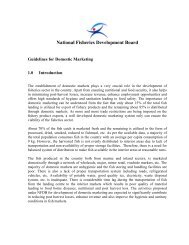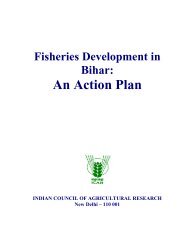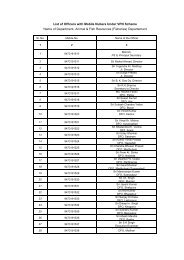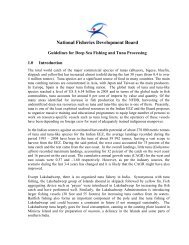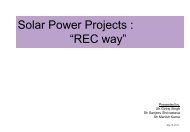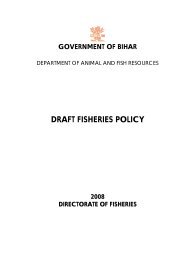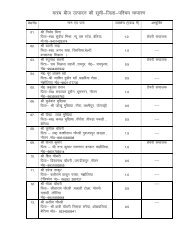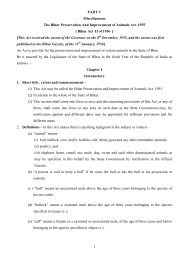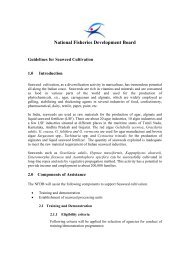National Fisheries Development Board - Animal & Fish Resources
National Fisheries Development Board - Animal & Fish Resources
National Fisheries Development Board - Animal & Fish Resources
You also want an ePaper? Increase the reach of your titles
YUMPU automatically turns print PDFs into web optimized ePapers that Google loves.
<strong>National</strong> <strong><strong>Fish</strong>eries</strong> <strong>Development</strong> <strong>Board</strong>Guidelines for Mariculture1.0 IntroductionWorld aquaculture production (food fish and aquatic plants) has grown significantlyduring the past half-a-century. FAO statistics shows that from a production of about 1million tonnes in the early 1950s, the world aquaculture production in 2004 was reportedto have risen to 59.4 million tonnes, with a value of US$ 70.3 billion. Of this, maricultureis reported to account for 36% of the total quantity and 33.6% of the total value ofaquaculture production. The potentially cultivable candidate species in India includeabout 20 species of finfishes, 29 crustaceans, 17 molluscs, 7 seaweeds and many otherspecies of ornamental and therapeutic value.2.0 Objectives of the scheme• To supplement the marine fish production through:i. production of fin fish seed by diversification of shrimp hatcheriesii. open sea cage culture.iii. Diversified mariculture through molluscan farming• Popularization of concept of the cage culture through setting of modeldemonstration and units and imparting training to the traditional fishermen3.0 Components of AssistanceThe NFDB will assist the following components:i) Production of finfish seed in shrimp hatcheriesii)iii)iv)Setting up of open sea cage cultureDemonstration of model sea cage culture to traditional fishermenMarine ornamental fish culturev) Molluscan farming including pearl culture3.1 Production of finfish seed from shrimp hatcheriesIn view of the need for diversification of the shrimp hatcheries, the scheme providesfor production of finfish seed.
3.1.1. Eligibility criteria• Individuals/Organizations with the ownership of shrimp/scampihatcheries located in coastal areas where the water resource issuitable for marine finfish seed production and clear title of landwhere the hatchery is situated.• Commitment of entrepreneur to bear 80% of the cost towardsdiversification.• Prospective entrepreneur should have received training, preferablyin finfish hatchery operations3.1.2 Type of AssistanceThe cost for development of shrimp hatchery includes repair/renovation/modification of the existing structures, additionaltanks/facilities for live feed culture, larval rearing, etc., and tentative unitcost and economics are indicated in Annexure-I. The assistance fromNFDB will be to the tune of 20% of the cost of diversification, as a backendedsubsidy.3.2 Setting up of open sea cage cultureIn view of the potential for open sea cage culture at several locations along theIndian coastline and the scheme provides for the activity.3.2.1 Eligibility criteria• Entrepreneurs/Companies with a previous record of undertakinglarge-scale aquaculture operations and having adequate on-shorefacilities for seed rearing.• Sea going fishermen by forming into groups and operating thescheme through <strong><strong>Fish</strong>eries</strong> federations/ corporations.• Availability of necessary clearances for undertaking the cageculture activity in the coastal areas.• Commitment of state fisheries Federations/ corporations,entrepreneur to bear 80% of the cost3.2.2 Type of AssistanceThe unit cost of a modern fish net cage system includes the cost of netmaterial, HDPE frames, floats, anchors and establishment of on-shorefacilities and the tentative unit cost and economics, for both large scale andsmall scale operations are indicated in Annexures II & III. The companieswilling to set up open sea cage culture in a big way shall be supported byNFDB through equity participation @ 20% of the investments.3.3 Demonstration of model cage culture to traditional fishermen
In order to train fishers in cage farming, it is proposed to set up model cagedemonstration farms, with a battery of cage units. Each unit would consistof HDPE framed cage with nylon net enclosures of different mesh sizes.High value fish seed will be stocked in these cages and reared for 6–8months, when they reach marketable size. This would form a productioncum demonstration facility, where in the fisherman co-operatives/SHGswill be beneficiaries.3.3.1 Eligibility criteria(i)For setting up demonstration farmsThe following criteria shall be applicable for the selection oforganization/agency for setting up demonstration farms:• ICAR Research Institutes/State <strong><strong>Fish</strong>eries</strong> Departments/ state<strong><strong>Fish</strong>eries</strong> Federations/Corporations, <strong><strong>Fish</strong>eries</strong> Colleges, withadequate facilities and background in coastal aquaculture andmariculture• Possessing adequate manpower and expertise to conductfrontline demonstration to traditional fishermen(ii)Selection of farmers/fisherman for receiving thedemonstrationThe following criteria shall be applicable for the selection offarmer/fisherman for receiving the demonstration:• Should be a fisherman with fishing/fish farming as the majoroccupation• Should be sponsored by State Government/<strong>Fish</strong>ermen Cooperatives/SHGs/<strong><strong>Fish</strong>eries</strong> <strong>Development</strong> Agencies• Priority should be given for fishermen affected by MarineProtected Areas/natural calamities.3.3.2 Type of AssistanceThe duration of each demonstration/training will be for a total of 10 daysin three spells, for a batch of about 25 trainees. The details of theassistance for training are given in Annexure-IV.3.4 Marine ornamental fish cultureIn recent years, a lucrative marine ornamental fish trade has emerged at aninternational level and the trade is getting expanded annually. It is a low volumehigh value enterprise and a long term sustainable trade of marine ornamentalscould be developed only hatchery-produced fish.
3.4.1 Eligibility CriteriaFor establishment of two demonstration hatcheries, Agencies withexpertise for ornamental fish seed production technologies would beconsidered and fishermen familiar with marine ornamental fishes would begiven preference for training.3.4.2 Type of AssistanceThe components of one unit of marine ornamental fish hatchery includesea water intake system, filtration system, FRP tanks, Live feed culturesystem and the costs for operation and demonstration are indicated inAnnexure-V.As regards Training component, the assistance for a standard trainingperiod of ten days is as indicated in Annexure-IV.3.5 Mussel FarmingMaritime states along the west coast of India have extensive estuaries, which opento the Arabian Sea. Based on the hydrographic condition, in most estuaries, twophases viz., a marine phase during December to May, and a brackish water phaseduring June to November have been observed. It is during the marine phase thatthe ecosystem becomes conducive for mussel culture. During 2005-06, theestimated farmed mussel production in the country was about 10,060 tonnes. TheNFDB envisages promotion of mussel farming in the maritime states of Indiathrough development fund assistance.3.5.1 Eligibility CriteriaThe criteria for selection of farmers/ fishers for grants for estuarine/ openseamussel farming are as follows:• Proximity of fishers/ farmers homestead to an estuarine water bodywith marine conditions during summer months/ Proximity offishers/ farmers homestead to calm seas• Proximity to sea where seed mussels will be available during postmonsoonmonths• Necessary clearances for undertaking mussel farming in coastalwaters3.5.2 Type of AssistanceThe components of one mussel farming unit include rack / raft holdingmussel ropes with semi-automatic seeder, de-clumper and post-harvest anddepuration facilities and the costs for operation and demonstration areindicated in Annexures-VI and VII.The NFDB assistance would be for Training and Demonstration in thepattern indicated in Annexure-IV.
3.6 Edible Oyster FarmingFarming of edible oyster (Crassostrea madrasensis) is being undertaken by smallscale farmers in shallow estuaries, bays and backwaters in a big way. In theadopted rack and ren method, a series of vertical poles are driven into the bottomin rows, on top of which horizontal bars are placed. Spat collection is done eitherfrom the wild or produced in hatcheries, on suitable cultch materials. Spatcollectors consist of clean oyster shells (5-6 Nos.) suspended on a 3 mm nylonrope at spaced intervals of 15-20 cm and suspended from racks, close to naturaloyster beds. Spat collection and further rearing is carried out at the same farm siteand harvestable size of 80 mm is reached in 8-10 months. Harvesting is donemanually with a production rate of 8-10 tonnes/ha. Oyster shells are also indemand by local cement and lime industry and culture production has increased to800 tonnes in the year 2000.3.6.1 Eligibility CriteriaThe criteria for selection of farmers/ fishers for grants for mussel farmingare as follows:• Proximity of fishers/ farmers homestead to an estuarine water bodywith marine conditions during summer months• Willingness of the entrepreneur to take up oyster farming• Necessary clearances for undertaking oyster farming in coastalwaters3.6.2 Type of AssistanceThe components of one Unit include rack and ren unit holding oyster renswith post-harvest and depuration facilities and the costs for operation anddemonstration are indicated in Annexure-VIII. The NFDB assistancewould be for Training and Demonstration in the pattern indicated inAnnexure-IV.3.7 Mabe Pearl ProductionA mabe pearl is a dome shaped or image pearl produced by placing a hemisphereor miniature image against the side of the oyster shell interior. These miniatureimages can be made into pendants, eardrops and rings. A fine quality mabe pearlof 10 mm size can fetch more than US$ 100 in international markets and anaverage of Rs. 1,000 in local markets. The advantage of Indian marine Mabes overthe ones produced in freshwater mussels is the short gestation period, apart fromthe superior quality of the nacre of Indian marine pearl oysters, Pinctada fucata.3.7.1 Eligibility CriteriaThe following criteria will be used to select farmers/ fishers for grants formabe pearl production:• Proximity of fishers/ farmers to calm seas
• Proximity to sea where pearl oysters (Pinctada fucata/ P.margaritifera) will be available3.7.2 Type of AssistanceComponents of one unit includes cages and rafts for holding oysters in theopen sea. The NFDB assistance would be for Training and Demonstration inthe pattern indicated in Annexure-IV.4.0 Submission of ProposalsThe proposals shall be submitted in the following forms:(i)(ii)(iii)Form - MC - I: Finfish seed production from shrimp hatcheries.Form – MC - II: Proposal for setting up open sea cage culture.Form – MC - III: Proposal for setting up demonstration farm forsea cage culture for traditional fishermen.(iv) Form–MC- IV: Application for training for sea cageculture/marine ornamental fish culture/mussel farming/edibleoyster farming/made pearl production/ and other finfish/shell fishof commercial importance.Application forms at Sl. Nos. (i) to (iii) above shall be filled up by the applicantand countersigned by the Implementing Agency. However, the application form atSl. No. (iv) prescribed for training and demonstration shall be filled up by theImplementing Agency and submitted to the NFDB for consideration.5.0 Release of fundsGenerally, the funds shall be released in two equal installments for activities relating toproduction of finfish seed from shrimp hatcheries, setting up of sea cage culture andsetting up demonstration farm for open sea cage culture and providing demonstration tofisherman. The first installment shall be released on approval of the proposal by theNFDB (and after 50% of the investment has been made by the entrepreneur in case ofsetting up of open sea cage culture farms) and the second installment shall be released atthe beginning of the seed production activity (in case of hatcheries) / entrepreneurinvesting the remaining 50% of his share (open sea cage culture) and on receipt of theutilization certificate from the Implementing Agency for the first installment. All subsidyinstallments shall be deposited in the bank account of the farmer.The funds for Training and Demonstration shall be released in a single installment, onapproval of the proposal by the NFDB.6.0 Submission of Utilization CertificateThe Implementing Agencies shall submit utilization certificates in respect of the fundsreleased to them by the <strong>Board</strong>. Such certificates shall be submitted in Form MC- V onhalf-yearly basis i.e. during July and January of each year. The utilization certificates canalso be submitted in between if activities for which funds were released earlier have been
completed and the next installment of subsidy is required to complete the remainingworks by the farmer.7.0 Monitoring and EvaluationA dedicated Monitoring and Evaluation (M & E) Cell shall be set up at NFDBHeadquarters to periodically monitor and evaluate the progress of activities implementedunder the NFDB funding. A project monitoring committee comprising of experts in thesubject matter, as well as finance and representatives of the Financing Organizations mayalso be constituted to periodically review the progress of the activities including theachievements related to physical, financial and production targets.
Annexure-IProduction of finfish seed from shrimp hatcheriesTentative unit cost and economics for production of 1million finfish seed<strong>Development</strong> of broodstock facility : Rs.15 lakhsCost of repair/renovation/modification ofexisting structures and cost of additional facilitiesFor larval rearing : Rs. 25 lakhsCost of repair/renovation/modification of existingstructures and cost of additional tanks for live feed production : Rs. 10 lakhsCost of repair/renovation/modification of existingstructures and cost of additional tanks : Rs.20 lakhsOperational costs per year : Rs. 30 lakhsDepreciation @20% : Rs.14 lakhsTotal : Rs.44 lakhsSale of 1 million finfish seed @ Rs.5/seed : Rs.50 lakhsProfit per year : 6 lakhs
Sl.NoAnnexure-IITentative Unit Cost and economics for Setting up of open sea cage cultureItemsCAPITAL INVESTMENT1 Fixed assetsOnshore facility ; floating cages(Apprx.12 meter dia;10 Nos) +working hut, motorized boats andother equipmentsCOST OF PRODUCTIONApprx. Cost/ crop (Rs. in lakh)I II III IV V60.0 -- -- -- --2 Depreciation on fixed assets (~10%) 6.0 6.0 6.0 6.0 6.03 Manpower10.0 11.0 12.0 13.0 14.0(1 manager @ Rs. 45000 per month) +(2 farm hands @ Rs. 20000 permonth) + bonus4 Fuel maintenance and miscellaneous 10.0 11.0 12.0 13.0 14.05 Onshore facility working charges (Lab 3.0 3.0 3.0 4.0 4.0works, water, electricity,communication, watch & ward etc.)6 Fry (20-25g size) (@ mean price of 5.0 10.0 10.0 11.0 11.0Rs.5/- : sea bass or grouper) (total1,00,000 seed for 10 cages)7 Feed (trash fish @ Rs. 5000/tonne; 18.0 36.0 36.0 36.0 36.0minimum of 6 tonnes required forproducing 1 tonne fish)8 Harvesting and transporting 2.0 4.0 4.0 5.0 5.09 Miscellaneous expenditure 2.0 2.0 2.0 3.0 3.010 Interest on borrowed money(~@8% 8.0 7.0 6.0 5.0 4.0per annum) (100 lakhs borrowed)11 Total cost of production64.0 90.0 91.0 96.0 97.0(2+3+4+5+6+7+8+9+10)Annual production (t) * (expectedabout 60 tonnes; at 80% survival andmean of 0.6 kg per fish)60tonnes120tonnes120tonnes120tonnes120tonnes12 Unit cost of production per tonne (6/7) 1.067 0.75 0.76 0.80 0.81Financial analysis13 Sale price (@Rs.100/ kg) 100/kg 110/kg 120/kg 130/kg 140/kg14 Revenue from sales 60.0 132.0 144.0 156.0 168.015 Profit over cost of production (14-11) -4.0 47.0 57.0 65.0 75.016 Repayment of loan 0 25.0 25.0 25.0 25.017 Net profit -4.0 22.0 32.0 40.0 50.0
Sl.NoAnnexure-IIITentative Unit Cost and economics for setting up of open sea cage culture in onecage for fisherman household/ SHGsItemsCAPITAL INVESTMENTApprx. Cost/ crop (Rs. in lakh)I II III IV V1 Fixed assets6.0 -- -- -- --Onshore facility ; floatingcages (Apprx. 12 meter dia; 1No. only)COST OF PRODUCTION2 Depreciation on fixed assets 0.6 0.6 0.6 0.6 0.6(~10%)3 Fry (20-25g size) (@ mean 0.5 1.0 1.0 1.1 1.1price of Rs.5/- : sea bass orgrouper) (total 10,000 seed percage)4 Feed (trash fish @ Rs.1.8 3.6 3.6 3.6 3.65000/tonne; minimum of 6tonnes required for producing 1tonne fish)5 Harvesting and transporting 0.25 0.50 0.50 0.50 0.506 Miscellaneous expenditure 0.20 0.20 0.20 0.30 0.307 Interest on borrowed0.8 0.7 0.6 0.5 0.4money(~@8% per annum) (10lakhs borrowed)8 Total cost of production 10.15 6.6 6.5 6.6 6.5(2+3+4+5+6+7)9 Annual production (t) *(expected about 60 tonnes; at80% survival and mean of 0.6kg per fish)6tonnes12tonnes12tonnes12tonnes12tonnes10 Unit cost of production per 1.69 0.55 0.54 0.55 0.54tonne (6/7)Financial Analysis13 Sale price (@Rs.100/ kg) 100/kg 110/kg 120/kg 130/kg 140/kg14 Revenue from sales 6.0 13.2 14.4 15.6 16.815 Profit over cost of production -4.15 6.6 7.9 9.0 10.3(14-11)16 Repayment of loan 0 2.5 2.5 2.5 2.517 Net profit -4.15 4.1 5.4 6.5 7.8
Summary of the Norms for Assistance towards TrainingAnnexure-IVSl.NoItem Activities Unit Cost Subsidy Remarks1.0 Training andDemonstration(i) Assistance to farmersfor participation in10 days trainingprogramme (batch of25 – 30).(i) Daily allowance of Rs 125/ day/trainee and reimbursement of actualto and fro travel, subject to amaximum of Rs 500 per trainee.(ii) Honorarium toResourcePersons.(iii) Assistance toimplementing agencyfor training anddemonstration.(ii)Honorarium of Rs 1250 and actual toand fro travel expenses, subject to amaximum of Rs 1000.(iii) Rs 75/ trainee/ day to theImplementing Agency towardsidentification, mobilization ofbeneficiaries, supply of trainingmaterial, etc.(iv) <strong>Development</strong> of demonstration unit@ Rs 1 00 000/- (one time grant) tothe Implementing Agency to conductregular training/ demonstrationactivities.(v)In absence of own facility, grant ofRs 50 000/- shall be available to theState Government to lease privateunit and its development for conductof training/ demonstration, etc.(vi) In the absence of (iv) and (v) above,Rs 5 000/- per training program forhiring suitable facility from privatefarmer.(vii) ICAR <strong><strong>Fish</strong>eries</strong> Institutes/ Collegesof <strong><strong>Fish</strong>eries</strong> under State AgricultureUniversities/ Other Agencies usingtheir own facilities will get a lumpsum amount of Rs 5 000/- pertraining programme for this purpose.
Annexure-VTentative Unit cost and economics for production of marine ornamental fishCost (Rs. lakhs)Capital Cost1. Fixed AssetsSea water intake , sedimentation, filtration system 25Blower +generator 5Air conditioner 1Broodstock development facilities (25 pair) and cost of broodstock 10Live feed culture facilities 5Larval rearing facilities 5Nursery grow out facilities 10Total Capital costs (A) 612. Operational costs (B) 103. Depreciation (@ 20% of the fixed Capital cost) (C) 12.2Total (B+C) 22.2Total Cost of Production (A+B+C) 83.24. Annual Production (Nos.)At survival (minimum 50%): Production : @300 seeds/ Month/PairTotal No. of seeds produced per month/30 pair: 9000Total No. of seeds produced per year/25 pair: 1,080005.Total No. of seeds produced per year (Round off) :100000 seedsFinancial analysisSale Price @Rs.50/seedRevenue from sale 50Gross Return (D) 50Production cost less depreciation {(D)- (B+C)} 27.8Gross Cash Return (E) 27.8Pay out period (A/D) 1.22
Annexure- VITentative cost benefit of Mussel Farming – Rack CultureRack size 30m x 20m (1200 ropes of 1 m)A. Initial ExpenditureI Farming1. Bamboo poles of 4m length 160 nos @ Rs. 110/- 17,600.002. Bamboo poles of 5m length 110 nos @ Rs. 125/- 13,750.003. Seeding rope 18mm (1500m), 300kg @ Rs. 125/- 37,500.004. Rope for lashing, tying the seeded rope; 4mm, 20 kg 2,650.005. Semi automated seeder 5,000.00 76,500.00II. Post Harvest6. De clumper 8,000.007. Plastic creates for depuration, (30 nos @ Rs.400/-) 12,000.008. Aluminium vessels for heat shucking 10,000.009. FRP tank, 2 ton for chlorination 12,000.0010. FRP tank, 1 ton for depuration 2 nos 12,000.001. 1HP pump, hose & accessories 10,000.00 64,000.00B. Capital CostDepreciation @ 50% for item 1 – 5 38,250.00Depreciation @ 20% for item 6 - 11 12,800.00 51,050.00C Recurring Cost1. Cotton netting (250mtr @ Rs.15/mtr) 3,750.002. Twine 100.003. Cost of seed (1800 kg @ Rs.6/kg) 10,800.004. Charge for seeding (30 man days @ Rs.200/head) 6,000.005. Hire charge of canoe 2,500.006. Charge for harvesting, de clumping and cleaning 10,000.007. Labour for depuration 3,000.008. Plastic wares 4,000.009. Marketing 5,000.0010. Miscellaneous 3,800.00 48,950.00Expenditure Total (B + C) 1,00,000.00D IncomeProduction of mussel 12000 kgHeat shucked meat (20%) 2400 kgSelling price Rs.80/kg 1,92,000.00E Net Income 92,000.00
Annexure- VIITentative cost benefit of Mussel Farming – Raft method in Open Sea Multiple (12)Units of 5m x 5m Rafts (300 sq. m)(600 ropes of 4m)A. Initial InvestmentI . Farming1. Bamboo poles of 5m length 240 nos @ Rs. 125/- 30,000.002. Empty oil barrels of 200 lt capacity, 60 nos @ Rs.500/- 30,000.003. Cast iron anchors of 30kg, 26 nos @ Rs.40/- 31,200.004. 18mm nylon rope for anchorage, 240 kg @ Rs.125/- 30,000.005. 4 mm nylon rope for lashing, 60 kg @ Rs.125/- 7,500.006. Rope for seeding 600 ropes of 4m; 480 kg @ Rs.125/- 60,000.007. Semi automated seeder 5,000.00 1,93,700.00II. Post Harvest8. De clumper 8,000.009. Semi automated seeder 5,000.0010. FRP tank of 2 ton capacity, 2 nos @ Rs.12,000/- 24,000.0011. FRP tank of 1 ton capacity 3 nos 18,000.0012 HP pump with hose & accessories 10,000.0013 Plastic crates for depuration 12,000.0014 Aluminium vessels for heat shucking 10,000.00 87,000.00B. Capital CostDepreciation @ 50% for item 1 – 7 96,850.00Depreciation @ 20% for item 8 - 14 17,400.001,14,250.00C Recurring Cost1. Cotton netting (600mtr @ Rs.15/mtr) 9,000.002. Labour for raft fabrication and mooring 24,000.003. Cost of mussel seed (4200 kg @ Rs.6/kg) 25,200.004. Seeding Charge (50 man days @ Rs.200/head) 10,000.005. Canoe hire charge 250 @ Rs.30/- 7,500.006. Harvesting and transportation 15,000.007. Labour for depuration 20,000.008. Labour for heat shucking 20,000.009. De clumping and washing 10,000.0010. Miscellaneous 10,000.001,50,700.00Expenditure Total (B + C)2,60,950.00DIncomeProduction of mussel 24000 kgHeat shucked meat (20%) 4800 kgSelling price Rs.80/kg 3,84,000.00E Net Income 92,000.00
Annexure- VIIITentative cost benefit of Rack culture for Edible Oyster300 sq. m. areaSl.No.Particulars Amount Total1 Capital Costa. Bamboo/casuarina pole (500 nos @ Rs.100/-) 50,000.00b. Nylon rope 4mm (180 kg @ Rs.140/-) 25,200.0075,200.00Less: Depreciation @ 50% 37,600.0037,600.002 Running Costa. Empty cleaned oyster shell (30,000 @ Rs. 0.15/-) 4,500.00b. Labour for making rack (6,000 @ Rs. 0.50/-) 3,000.00c. Rack construction 5,000.00d. Harvesting 5,000.00e. Cleaning the harvested oyster 3,000 ton 12,000.00f. Heat shucking 54,000.00g. Marketing exp. @ Rs.2/kg for 2,500 5,000.00 88,500.00Total Expenditure 1,26,100.00Sale proceeds: Meat @ 80/kg 2,00,000.00Net profit 73,900.00
FORM – MC-IProposal for taking up Finfish Seed Production in Shrimp HatcheriesSl.Information furnished byParticulars sought from the applicantNothe applicant(1) (2) (3)1.0 Name and address of the applicant/ firm/ association/Self Help Group (IN BLOCK LETTERS):2.03.04.0Address for communicationTelephone:Fax:Mobile:E-mail:Details of land where the shrimp hatchery is locatedwhich is proposed to be upgraded to a finfishhatchery:a) State:b) District:c) Taluk/ Mandal:d) Revenue Village:e) Survey No.:f) Whether located in the permitted zone as perthe CRZ Act:g) Ownership (whether freehold or on lease):h) If on lease, duration of lease:i) Total land area of the existing shrimphatchery (in ha):j) Capacity of the shrimp hatchery:k) No. of tanks with tonnage:l) Water holding capacity:m) Other amenities available:n) Water intake and filtration system:o) Drainage water treatment facility:p) Live feed culture facility:q) Laboratory facility for disease diagnosis andwater quality analysis:Details of the proposed marine finfish hatcherya) Extent of additional area available forupgrading to finfish seed production:b) Numbers and size of brood stock tanks:c) Numbers and size of hatching tanks:d) Numbers and size of live feed tanks:
(1) (2) (3)e) Numbers and size of nursery tanks:f) Details of aeration facility:g) Drainage water treatment facility:h) Technology to be adopted(imported/indigenous):i) Production capacity (in million fry perproduction cycle):j) Number of seed production cycles proposedper year:k) Facilities, if any for nursery rearing. If so,capacity of the nurseries:l) Source and quality of water:m) Source of brood stock:n) Details of the proposed construction works inthe hatchery. (Design details/engineeringworks to be submitted):o) Details of feed for brood stock and fry; andfeed storage facility:p) Live feed culture facility:q) Laboratory facility for disease diagnosis andwater quality analysis:5.0 Details on tie up with the Bank for availinginstitutional finance:6.0 Arrangement for seed money (please furnishdocumentary proof, such as statement of Bankaccount, etc.):7.0 Whether the applicant is in default of payment to anyFinancial Institution/ State Government for loan/assistance availed earlier. If yes, please provide thedetails and the reasons for default:8.0 Experience of the applicant in operation ofhatcheries and details of training(s) undergone sofar:9.0 Details regarding economics of operation:10.0 Marketing tie up:11.0 Expected date of operation of the hatchery andtentative schedule of activities such as distributionand marketing of seed and transport arrangements,etc:12.0 Number of existing finfish hatcheries set up within aradius of 50 kms of the proposed hatchery and theirproduction capacities:13.0 Source and number of workers employed forconstruction as well as day-today hatcheryoperations: (man days per year):
Declaration by the ApplicantI/We………....……………………..………………………...…………..son/daughter/wifeof………………………………...……………………………………….................residingat………………………………………................................……………………………….hereby declare that the information furnished above is true to the best of my/ ourknowledge and belief. I am/ we are fully aware that if it is found that the informationfurnished by me/ we is false or there is any kind of deviation/ violation of the conditionsunder which assistance is provided to me by the NFDB, any action as deemed fit forviolation of this condition may be taken against me/ us.Date:Place:(s)Signature of the ApplicantCountersigned by the Implementing AgencyDate:Place:Signature and seal of the authorizedrepresentative of the ImplementingAgency
Proposal for setting up open sea cage cultureFORM – MC-IISl.NoParticulars sought from the applicant Information furnishedby the applicant(1) (2) (3)1.0 Name and address of the company/ firm(IN BLOCK LETTERS):2.0 Address for communicationTelephoneFaxMobile:E-mail:3.0 Details of the area where sea cage culture activity isproposed to be taken up:a) State:b) District:c) Taluk/ Mandal:d) Near by Revenue Village:e) Latitude and longitude :f) Details of lease:g) Duration of lease:h) Total farm area (in ha):i) Details of the proposed construction works of cagefarms. (Design details/engineering works to besubmitted):j) Number of cage units:k) Dimensions of each cage:l) Maximum fish holding capacity in each cage:m) Details of other structures including floats,anchors, watch towers, light-buoys:n) Details of mechanized/motorized crafts fortransporting men and material to and fro:4.0 On-shore facilities for the cage farm: Details of the areawhere the on-shore facility is proposed to be taken upa) State:b) District:c) Taluk/ Mandal:d) Near by Revenue Village:e) Survey Number :f) Whether located in the permitted zone as per theCRZ Act:g) Ownership (whether free hold or open lease):h) If on lease, details and duration of lease:
(1) (2) (3)i) Details of the proposed construction works of onshorefacility. (Design details/engineering works tobe certified and approved by the CompetentAuthority):j) Species and source of fry:k) Details of the holding facility for the seed (fry tofingerling):l) Number and dimensions of fry rearing tanks:m) Water intake and treatment facility:n) Source and quality of water:o) Drainage water treatment facility:p) Details of feed to be used for fry:q) Storage facility for feed (for rearing and seedcultured fish):r) Frozen / Chilled storage facility for harvested fish:s) Details of mechanized/motorized crafts fortransporting men and material to and fro:t) On-shore laboratory for monitoring water qualityparameters and disease diagnosis in the cage farmsite:u) Communication facility (wireless/mobile) betweenon-shore and sea cage facilities:5.0 Whether the assistance for the sea cage culture has beensought under any other scheme of the Central/StateGovernment? If so, please provide the details:6.0 Whether the Company/Firm is in default of payment toany financial institution/State Government forloan/assistance availed earlier. If yes, please provide thedetails and the reasons for default:7.0Estimates regarding input cost:a) Species to be cage cultured:b) Stocking density (please specify the stage ofstocking – fry/fingerling) – numbers per cubicmeter of cage:c) Cost of seed (Rs. per thousand):d) Source of procurement:e) Transportation cost (Rs. Per thousand):f) Details of feed to be used, its quantity and cost:g) Source of procurement of feed:h) Transportation cost of feed from on-shore facilityto the cage culture site:i) Number of culture cycles per year:j) Salaries/wages:k) Harvesting cost:l) Operational cost for the on-shore facility:
(1) (2) (3)8.0 Experience of the applicant in the cage culture and detailsof training(s) undergone so far:9.0 Details regarding economics of operation:10.0 Whether any financial tie up has been made for availingBank loan, if so please provide the details:11.0 Expected date of operation of the farm and tentativeschedule of activities:12.0 Marketing tie up:13.0 Source and number of labour employed for constructionas well as day-today culture operations (man days peryear):Declaration by the Authorized Signatory of the Company/FirmI/We……...........……………..………………………………………............son/daughter/wifeof………………..…...……………………...……………………………………..…...residingat………………………….....………………..…………………………………hereby declarethat the information furnished above is true to the best of my/ our knowledge and belief. Iam/ we are fully aware that if it is found that the information furnished by me/ we is false orthere is any kind of deviation/ violation of the conditions under which assistance is providedto me by the NFDB, any action as deemed fit for violation of this condition may be takenagainst me/ us.Date:Place:(s)Signature of the applicantCountersigned by the Implementing AgencyDate:Place:Signature and seal of the authorizedrepresentative of the ImplementingAgency
FORM – MC- IIIProposal for setting up sea cage culture for fishermenSl.NoParticulars sought from the applicant Information furnishedby the applicant(1) (2) (3)1.0 Name and address of the Implementing Agency(IN BLOCK LETTERS):2.0 Address for communicationTelephone:Fax:Mobile:E-mail:3.0 Facilities available/proposed for the demonstration4.0 Details of the area where sea cage demonstrationactivity is proposed to be taken up:a) State:b) District:c) Taluk/ Mandal:d) Near by Revenue Village:e) Latitude and longitude :f) Details of lease:g) Duration of lease:h) Total farm area (in ha):i) Details of the proposed construction works ofdemonstration cage farms. (Designdetails/engineering works to be submitted):j) Number of demonstration cage units:k) Dimensions of each demonstration cage:l) Maximum fish holding capacity in eachdemonstration cage:m) Details of other structures including floats,anchors, watch towers, light-buoys:n) Details of mechanized/motorized crafts fortransporting men and material to and fro:5.0 On-shore facilities for the demonstration cage farm:Details of the area where the on-shore facility isproposed to be taken upa) State:b) District:c) Taluk/ Mandal:d) Near by Revenue Village:e) Survey Number :f) Whether located in the permitted zone as perthe CRZ Act:g) Ownership (whether free hold or open lease):h) If on lease, details and duration of lease:
(1) (2) (3)i) Details of the proposed construction works ofon-shore demonstration facility. (Designdetails/engineering works to be certified andapproved by the Competent Authority):j) Species and source of fry:k) Details of the holding facility for the seed(fry to fingerling):l) Number and dimensions of fry rearing tanks:m) Water intake and treatment facility:n) Source and quality of water:o) Drainage water treatment facility:p) Details of feed to be used for fry:q) Storage facility for feed (for rearing seed andcultured fish):r) Frozen / Chilled storage facility for harvestedfish:s) Instruction room facility:t) Details of mechanized/motorized crafts fortransporting men and material to and fro:u) On-shore laboratory for monitoring waterquality parameters and disease diagnosis inthe cage farm site:v) Communication facility (wireless/mobile)between on-shore and sea cagedemonstration facilities:6.0 Number of persons to be trained in sea cage cultureper training programme7.0 Whether the assistance for the sea cagedemonstration facility has been sought under anyother scheme of the Central/State Government? Ifso, please provide the details:8.0 Estimates regarding input cost:a) Species to be cage cultured fordemonstration:b) Stocking density (please specify the stage ofstocking – fry/fingerling) – numbers percubic meter of cage:c) Cost of seed (Rs. per thousand):d) Source of procurement:e) Transportation cost (Rs. per thousand):f) Details of feed to be used, its quantity andcost:g) Source of procurement of feed:h) Transportation cost of feed from on-shorefacility to the cage culture site:i) Number of culture cycles per year:j) Salaries/wages:
(1) (2) (3)k) Harvesting cost:l) Operational cost for the on-shore facility:9.0 Experience of the organization in the cage culture:10.0 Details regarding economics of operation:11.0 Expected date of operation of the demonstration seacage culture farm and tentative schedule ofactivities:12.0 Marketing tie up:13.0 Source and number of labour employed forconstruction as well as day-today culture operations(man days per year):14.0 Financial Implications for demonstration:Item Number AmountTrainingi. Assistance to fishermen @ Rs 125/ day for atotal duration of 10 days (in 3 spells):ii. Reimbursement of to and fro travel expenses tofishermen (3 spells):iii. Assistance to implementing agency @ Rs 75/trainee/ day:iv. Honorarium to resource persons andreimbursement of to and fro travel expenses asper their entitlement:TotalDeclaration by the Authorized Signatory of the Organization/FirmI/We…………………………………………………..........……………………..son/daughter/wifeof………………..………………………...………......………..…………………………...residingat…………………………………………………………………………hereby declare that theinformation furnished above is true to the best of my/ our knowledge and belief. I am/ we arefully aware that if it is found that the information furnished by me/ we is false or there is any kindof deviation/ violation of the conditions under which assistance is provided to me by the NFDB,any action as deemed fit for violation of this condition may be taken against me/ us.Date:Place:Signature of the applicant (s)Countersigned by the Implementing AgencyDate:Place:Signature and seal of the authorizedrepresentative of the ImplementingAgency
FORM – MC-IVProposal for Training in Sea Cage Culture/ Marine Ornamental <strong>Fish</strong>Culture/Mussel Farming/Edible Oyster Farming/Mabe Pearl ProductionSl. Particulars sought from the Trainee Information furnished by the TraineeNo(1) (2) (3)1.0 Name and postal address of the Trainee:2.0 Location of the Trainee:District Block Panchayat Village3.0 Age and Date of Birth:4.0 Sex:5.0 Voter’s ID Card No.:6.0 Occupation:7.0 Annual Income:8.0 Whether belong to SC/ST/OBC9.0 Whether a member of <strong>Fish</strong>ermen Co-operativeSociety/SHG. If so;• Name & Address of the <strong>Fish</strong>ermen CooperativeSociety/SHG:• Member Since When:• Membership ID No.:10.0 Has any previous experience in aquaculture, if so,specify details:11.0 Distance from the location of the training site:12.0 How this training programme to be made use:13.0 Signature of the Applicant:To be forwarded by the Sponsoring/Nominating Agency14.0 Recommendation of the Agency :• Whether after training the agency would takeup cage culture in co-operative/SHG mode:15.0 Name and Signature of the Authorized Signatoryof the Nominating Agency:16.0 Financial Implications:Item Number Amounta) Training(i) Assistance to farmer @ Rs 125/ day for 10days:(ii) Reimbursement of to and fro travelexpenses to farmer:(iv) Honorarium to resource persons andreimbursement of to and fro travelexpenses:(iii) Assistance to implementing agency @ Rs75/ trainee/ day:Total10.0 Technical capabilities of resource persons to beengaged in training:11.0 Any other details in support of the proposal
Declaration by the ApplicantI/We………………………….………......…………………..…………..son/daughter/wifeof………………..………………………...…...…………………………………...residingat…………………………………………………………………………hereby declarethat the information furnished above is true to the best of my/ our knowledge and belief.I am/ we are fully aware that if it is found that the information furnished by me/ we isfalse or there is any kind of deviation/ violation of the conditions under which assistanceis provided to me by the NFDB, any action as deemed fit for violation of this conditionmay be taken against me/ us.Date:Place:(s)Signature of the ApplicantCountersigned by the Nominating/Sponsoring AgencyDate:Place:Signature and seal of the authorizedRepresentative of the Nominating/Sponsoring Agency
FORM –MC- V<strong>National</strong> <strong><strong>Fish</strong>eries</strong> <strong>Development</strong> <strong>Board</strong>Form for Submission of Utilization CertificateSl. No Letter No and date Amount Certified that out of Rs. ___________sanctioned during the year_________in favour of _______________ underthe <strong>National</strong> <strong><strong>Fish</strong>eries</strong> <strong>Development</strong><strong>Board</strong>’s Letter No given in the marginand Rs. _______________ on accountof unspent balance of the previoussanction, a sum of Rs. ___________has been utilized for the purposeof____________ for which it wassanctioned and that the balance ofRs. ___________ remains unutilized.The same will be adjusted towards thenext instalment payable during theperiod ____________.Physical progress:Certified that I have satisfied myself that the conditions on which the funds weresanctioned by the <strong>National</strong> <strong><strong>Fish</strong>eries</strong> <strong>Development</strong> <strong>Board</strong> have been duly fulfilled/ arebeing fulfilled and that I have exercised the following checks to see that the money wasactually utilized for the purpose for which it was sanctioned.Date:Place:Signature and seal of the authorizedrepresentative of the ImplementingAgency



